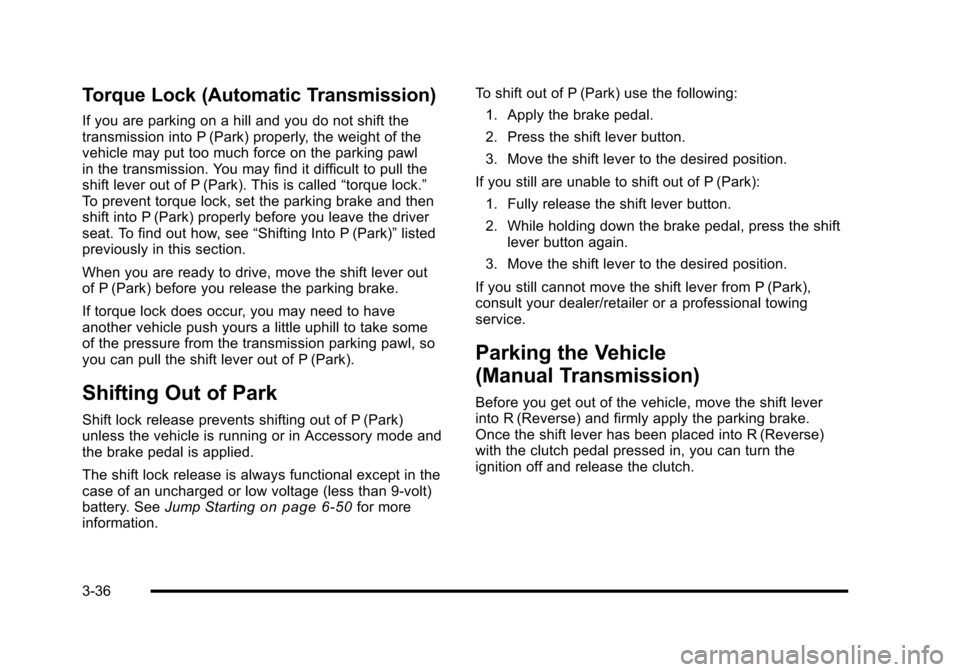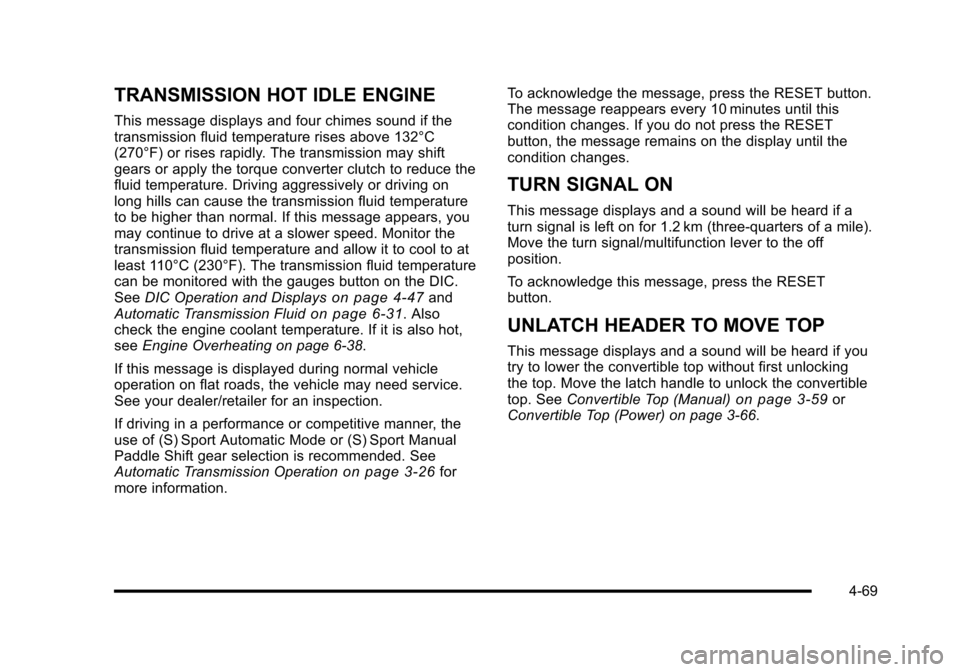Page 132 of 472

Torque Lock (Automatic Transmission)
If you are parking on a hill and you do not shift the
transmission into P (Park) properly, the weight of the
vehicle may put too much force on the parking pawl
in the transmission. You may find it difficult to pull the
shift lever out of P (Park). This is called “torque lock.”
To prevent torque lock, set the parking brake and then
shift into P (Park) properly before you leave the driver
seat. To find out how, see “Shifting Into P (Park)”listed
previously in this section.
When you are ready to drive, move the shift lever out
of P (Park) before you release the parking brake.
If torque lock does occur, you may need to have
another vehicle push yours a little uphill to take some
of the pressure from the transmission parking pawl, so
you can pull the shift lever out of P (Park).
Shifting Out of Park
Shift lock release prevents shifting out of P (Park)
unless the vehicle is running or in Accessory mode and
the brake pedal is applied.
The shift lock release is always functional except in the
case of an uncharged or low voltage (less than 9‐volt)
battery. See Jump Starting
on page 6‑50for more
information. To shift out of P (Park) use the following:
1. Apply the brake pedal.
2. Press the shift lever button.
3. Move the shift lever to the desired position.
If you still are unable to shift out of P (Park): 1. Fully release the shift lever button.
2. While holding down the brake pedal, press the shift lever button again.
3. Move the shift lever to the desired position.
If you still cannot move the shift lever from P (Park),
consult your dealer/retailer or a professional towing
service.
Parking the Vehicle
(Manual Transmission)
Before you get out of the vehicle, move the shift lever
into R (Reverse) and firmly apply the parking brake.
Once the shift lever has been placed into R (Reverse)
with the clutch pedal pressed in, you can turn the
ignition off and release the clutch.
3-36
Page 237 of 472

TRANSMISSION HOT IDLE ENGINE
This message displays and four chimes sound if the
transmission fluid temperature rises above 132°C
(270°F) or rises rapidly. The transmission may shift
gears or apply the torque converter clutch to reduce the
fluid temperature. Driving aggressively or driving on
long hills can cause the transmission fluid temperature
to be higher than normal. If this message appears, you
may continue to drive at a slower speed. Monitor the
transmission fluid temperature and allow it to cool to at
least 110°C (230°F). The transmission fluid temperature
can be monitored with the gauges button on the DIC.
See DIC Operation and Displays
on page 4‑47and
Automatic Transmission Fluidon page 6‑31. Also
check the engine coolant temperature. If it is also hot,
see Engine Overheating on page 6‑38.
If this message is displayed during normal vehicle
operation on flat roads, the vehicle may need service.
See your dealer/retailer for an inspection.
If driving in a performance or competitive manner, the
use of (S) Sport Automatic Mode or (S) Sport Manual
Paddle Shift gear selection is recommended. See
Automatic Transmission Operation
on page 3‑26for
more information. To acknowledge the message, press the RESET button.
The message reappears every 10 minutes until this
condition changes. If you do not press the RESET
button, the message remains on the display until the
condition changes.
TURN SIGNAL ON
This message displays and a sound will be heard if a
turn signal is left on for 1.2 km (three-quarters of a mile).
Move the turn signal/multifunction lever to the off
position.
To acknowledge this message, press the RESET
button.
UNLATCH HEADER TO MOVE TOP
This message displays and a sound will be heard if you
try to lower the convertible top without first unlocking
the top. Move the latch handle to unlock the convertible
top. See
Convertible Top (Manual)
on page 3‑59or
Convertible Top (Power) on page 3‑66.
4-69
Page 395 of 472
Tightening Wheel Lug Nuts
{WARNING:
Never use oil or grease on studs or the threads of
the wheel nuts. If you do, the wheel nuts might
come loose and the wheel could fall off, causing
a crash.
{WARNING:
Incorrect wheel nuts or improperly tightened wheel
nuts can cause the wheel to become loose and
even come off. This could lead to a crash. Be sure
to use the correct wheel nuts. If you have to
replace them, be sure to get new GM original
equipment wheel nuts. Notice:
Improperly tightened wheel nuts can lead
to brake pulsation and rotor damage. To avoid
expensive brake repairs, evenly tighten the wheel
nuts in the proper sequence and to the proper
torque specification.
Tighten the wheel lug nuts
firmly in a crisscross
sequence as shown.
6-83
Page 421 of 472
Application Capacities
Metric English
Transmission Fluid
Automatic Transmission (Pan Removal and Filter
Replacement) 6.2 L
6.5 qt
Manual Transmission –Base 3.5 L3.6 qt
Manual Transmission –Z16 4.0 L4.2 qt
Manual Transmission –Z06 4.3 L4.5 qt
Manual Transmission –ZR1 4.3 L4.5 qt
Wheel Nut Torque 140 Y 100 lb ft
All capacities are approximate. When adding, be sure to fill to the approximate level, as recommended in this manual.
Recheck fluid level after filling
Engine Specifications
Engine VIN CodeTransmission Spark Plug Gap Firing Order
6.2L LS3 V8 W Automatic
Manual 1.016 mm (0.040 in) 1–8–7–2–6–5–4–3
6.2L LS9 V8 TManual1.016 mm (0.040 in) 1–8–7–2–6–5–4–3
7.0L LS7 V8 EManual1.016 mm (0.040 in) 1–8–7–2–6–5–4–3
6-109
Page 422 of 472
Engine Data
EngineHorsepower TorqueDisplacement Compression Ratio
6.2L LS3 V8 without
option NPP 430 @ 5900 rpm 424 lb ft @ 4600 rpm
6.2L10.69:1
6.2L LS3 V8 with
option NPP 436 @ 5900 rpm 428 lb ft @ 4600 rpm
6.2L10.69:1
6.2L LS9 V8
Supercharged 638 @ 6500 rpm 604 lb ft @ 3800 rpm
6.2L9.10:1
7.0L LS7 V8 505 @ 6300 rpm 470 lb ft @ 4800 rpm 7.0L11.00:1
6-110